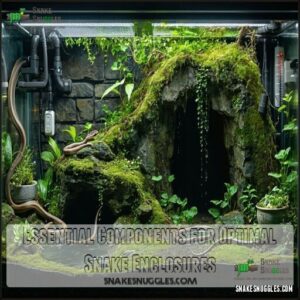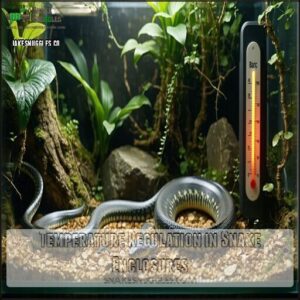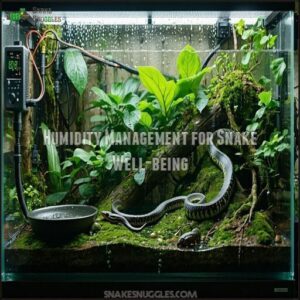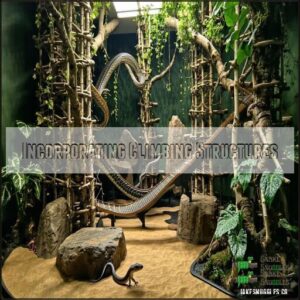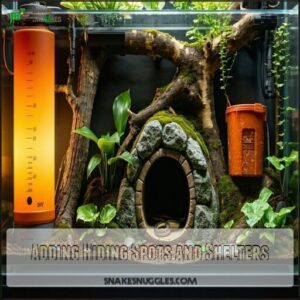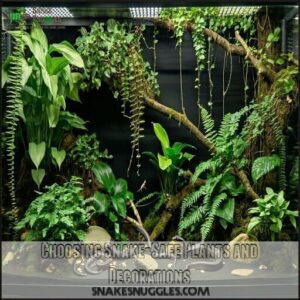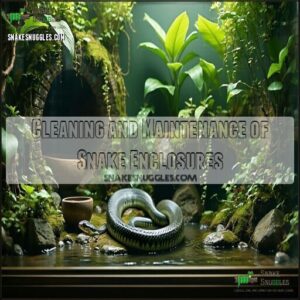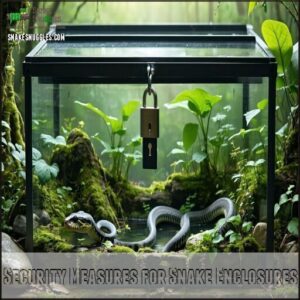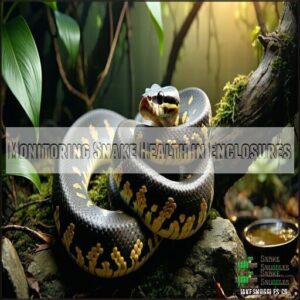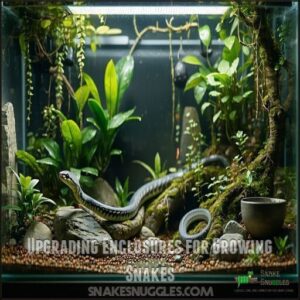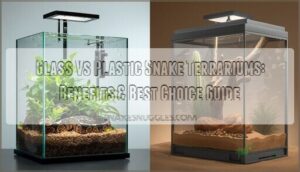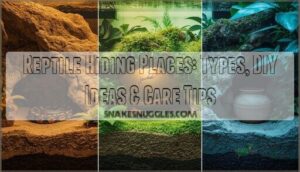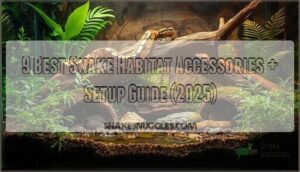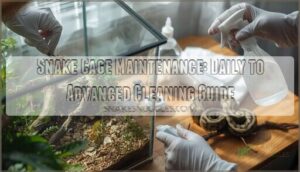This site is supported by our readers. We may earn a commission, at no cost to you, if you purchase through links.

Choose a terrarium at least two-thirds of your snake’s length, with escape-proof lids and proper ventilation.
Use substrates like aspen shavings or coconut husk for easy cleaning and humidity regulation.
Maintain a temperature gradient: a warm side (85-90°F) with a heat mat or ceramic heater and a cooler side (75-80°F).
Provide a water bowl, hiding spots, and climbing branches for enrichment.
Add snake-safe plants for a natural touch—but skip anything sharp, unless your snake’s a daredevil.
Curious about the perfect humidity levels or lighting tricks? Our experts can provide guidance on creating the ideal environment with the right temperature control.
Table Of Contents
- Key Takeaways
- Essential Components for Optimal Snake Enclosures
- Creating a Naturalistic Snake Habitat
- Temperature Regulation in Snake Enclosures
- Humidity Management for Snake Well-being
- Designing Safe and Stimulating Snake Environments
- Cleaning and Maintenance of Snake Enclosures
- Security Measures for Snake Enclosures
- Monitoring Snake Health in Enclosures
- Upgrading Enclosures for Growing Snakes
- Frequently Asked Questions (FAQs)
- How to properly set up a snake enclosure?
- What should a snake enclosure have?
- What do you put in the bottom of a snake tank?
- Do snakes prefer tight spaces?
- How do I choose a snake enclosure?
- Do snakes need a vertical enclosure?
- Where can I find a snake enclosure?
- What are the best snake enclosures?
- How should a snake tank be set up?
- What are the proper enclosures for snakes?
- Conclusion
Key Takeaways
- Make sure your snake’s enclosure is secure, escape-proof, and well-ventilated, with a size that’s at least two-thirds of its length.
- Provide a temperature gradient by setting up a warm side (85-90°F) and a cool side (75-80°F) using heat mats or ceramic heaters.
- Add hides, climbing branches, and safe substrates like coconut husk or aspen shavings to mimic natural environments and reduce stress.
- Maintain proper humidity levels with tools like hygrometers, misting systems, and water bowls, ensuring comfort and aiding in healthy shedding.
Essential Components for Optimal Snake Enclosures
You’ll need to make strategic choices when setting up your snake’s home to guarantee its comfort, health, and safety.
Smart setup choices create a cozy, safe haven where your snake can thrive in comfort and health.
From selecting the right terrarium size to incorporating critical elements like proper substrate, heating, and humidity control, creating an ideal snake enclosure requires careful planning and attention to detail.
Choosing The Right Size Terrarium
When choosing a terrarium, size matters—big time! Your snake’s habitat should be at least two-thirds its body length, giving it room to stretch, explore, and thrive.
Here’s what you’ll want to examine:
- Measure your snake’s full length carefully
- Allow extra space for climbing and movement
- Choose a design that supports natural behaviors
- Prioritize ventilation and comfort
A well-sized enclosure isn’t just about dimensions; it’s about creating a home where your scaly friend feels secure and happy. Understanding proper snake terrarium setups is vital for creating an ideal environment.
Selecting Appropriate Substrate Materials
After selecting the perfect terrarium, you’ll want to nail your substrate strategy. Your snake’s comfort depends on smart material choices that balance hygiene, humidity, and habitat mimicry.
Here’s why substrate matters:
- Prevents skin irritation
- Regulates environmental moisture
- Supports natural burrowing behaviors
- Reduces stress for your slithery friend
Substrate options like Eco Earth, aspen shavings, and coconut husk each bring unique benefits. Consider your snake’s species and native environment when selecting. Reptile carpet works for some, while bioactive mixes provide a more naturalistic setup. Always prioritize material safety and avoid substrates that could cause respiratory issues or impaction.
Choosing the right substrate is vital for maintaining prime snake health conditions to guarantee your pet’s wellbeing, as discussed in the article about snake health conditions.
Incorporating Heating Elements
Every seasoned snake keeper knows heat is the secret sauce of reptile comfort.
Your best bet is a strategically placed heat mat covering one-third of the enclosure, paired with a reliable thermostat.
This dynamic duo guarantees a perfect temperature control strategy, preventing your scaly friend from turning into a reptilian toast.
Radiant heat panels work wonders for larger setups, distributing warmth like a cozy blanket.
But remember, safety first—secure those heating systems to keep your snake warm, not worried, and always comfortable in its new home.
For superior results, consider using heat mat products to achieve the desired temperature.
Installing Proper Lighting Systems
After setting up your snake’s cozy heating zone, it’s time to illuminate their world with smart lighting systems. Your reptilian friend needs more than just brightness—they require strategic illumination that mimics natural environments.
Consider these lighting game-changers:
- UVB lighting boosts snake coloration and activity levels
- LED systems provide energy-efficient, consistent illumination
- Automated timer settings replicate natural day/night cycles
Heat lamps paired with sturdy fixtures create the perfect ambiance without risking burns. While snakes aren’t sunbathing socialites, they appreciate carefully designed lighting that supports their physiological needs.
A well-planned lighting hood keeps bulbs safely outside the enclosure, preventing accidental contact and ensuring your snake’s habitat feels like a five-star reptile resort.
Adding Humidity Control Devices
After fine-tuning your snake’s lighting, master humidity control with precision.
Snag a digital hygrometer to track moisture levels like a pro—these tiny sensors are your environmental guardians.
MistKing misting systems and strategic fogging techniques can transform your terrarium’s microclimate.
Position a sturdy water bowl near heating elements to boost evaporation naturally.
Desert snake? Calibrate your humidifier options carefully, using smaller water dishes and evaporative coolers.
Pro tip: Create a humid hide box packed with damp moss—your snake’s ultimate shedding sanctuary.
Complement these strategies with humidity-retaining substrates like coconut husk or cypress mulch, turning your enclosure into a perfectly balanced reptilian paradise, and remember to use a digital hygrometer to ensure the right conditions, with MistKing misting systems and strategic fogging techniques for optimal results, and don’t forget the importance of a sturdy water bowl.
Creating a Naturalistic Snake Habitat
From the ground up, transform your snake’s home into a slice of wild paradise with a thoughtful naturalistic habitat design.
Transform your snake’s enclosure into a wild paradise, blending nature-inspired design with comfort for a thriving, happy reptile.
Craft a bioactive substrate that mimics natural terrain, incorporating live plants like hardy Pothos to boost humidity and provide exploration zones.
Strategic driftwood and climbing branches invite natural behaviors, while a well-placed bark hide offers security.
By blending environmental enrichment with careful vivarium landscaping, you’ll create a terrain that doesn’t just house your snake—it lets them thrive.
Creating a naturalistic environment requires understanding temperature gradient systems to guarantee the snake’s comfort and health, which is crucial for a bioactive substrate that supports the overall well-being of your snake in its new wild paradise.
Temperature Regulation in Snake Enclosures
You’ll want to nail your snake’s temperature regulation to keep your scaly friend healthy and thriving.
Creating the right thermal gradient in your enclosure isn’t just important—it’s essential for mimicking your snake’s natural habitat and supporting its metabolic functions.
Establishing Proper Temperature Gradients
Creating a temperature gradient gives your snake control over its body temperature, just like adjusting your home thermostat. Snakes need warm and cool zones for proper temperature regulation and thermoregulation.
Here’s how to achieve the perfect balance:
- Set the warm side between 80-85°F, and the cool side at 75-82°F.
- Add a basking spot of 88-92°F for effective thermoregulation.
- Use a heat mat with a reliable thermostat for precise temperature control.
- Monitor your thermal gradient with digital thermometers to maintain consistency.
Your snake’s comfort depends on it!
Selecting Effective Heat Sources
In regards to heating your snake’s home, selecting the right heat sources guarantees comfort and effective thermoregulation.
Heat mats are perfect for belly heat and work quietly, while ceramic heaters provide steady warmth without light—ideal for larger enclosures.
For pinpoint heat distribution, heat lamps create excellent basking spots. Thermostats are essential for keeping all devices in check.
Here’s a quick comparison:
| Heat Source | Best For | Key Benefit |
|---|---|---|
| Heat Mats | Belly warmth | Affordable, quiet |
| Ceramic Heaters | Larger enclosures | Light-free heating |
| Heat Lamps | Basking spots | Precise gradients |
| Heat Cables | Custom warming zones | Flexible setup |
Monitoring Temperature Accurately
Staying on top of temperature regulation means keeping your heat mat and thermostat in sync. Don’t just trust a single reading—aim for accurate tracking!
- Use multiple thermometers to monitor the temperature gradient across warm and cool sides.
- Regularly check your thermostat settings to confirm heat sources are operating correctly.
- Invest in digital temperature control tools with data-logging features for detailed patterns.
- Calibrate your sensors periodically for precise humidity levels and ambient temperatures.
Your snake’s comfort depends on precision. Think of it like perfecting your home’s thermostat—consistent, stable warmth means a stress-free, healthy environment for your slithering companion!
Adjusting for Day and Night Cycles
Your snake’s health relies on a well-regulated day-night cycle. Implement a lighting system with UVB bulbs and timers for accurate photoperiod adjustment, providing 12-hour light cycles and 12 hours of darkness.
Slightly reduce the heat pad at night to mimic natural temperature fluctuations. Here’s a quick guide:
| Time | Light Cycle | Temperature Gradient | Humidity Swings |
|---|---|---|---|
| Day (12 hrs) | UVB On | 80-90°F | Misted (Higher) |
| Night (12 hrs) | UVB Off | 75-80°F | Stabilized (Lower) |
These circadian rhythms optimize digestion and behavior, ensuring comfort and thermoregulation.
Humidity Management for Snake Well-being
Keeping your snake’s enclosure at the right humidity level is essential for its health and shedding. Use tools like hygrometers, misting systems, and moisture-retaining substrates to maintain consistent conditions.
Maintaining Ideal Humidity Levels
Humidity control is vital for your snake’s health and comfort.
Use a hygrometer to measure levels precisely, aiming for the ideal range your species needs.
Balance moisture with a few smart steps:
- Water bowls: Keep one in the enclosure for drinking and skin hydration.
- Humidity-retaining substrates: Coconut husk or cypress mulch can maintain consistent moisture.
- Ventilation systems: Make certain airflow to avoid mold while keeping the enclosure humid.
- Humid hide: Create a damp spot where your snake can enjoy extra moisture.
It’s all about balance—neither too dry nor too damp!
Incorporating Misting Systems
Bumping up your enclosure’s comfort zone isn’t hard with a misting system. Fine-tuned mist controls paired with thoughtful terrarium design ideas can mimic a rainforest, keeping your snake thriving.
Strategically place spray nozzles to create an even mist—soft enough for humidity control without drenching your reptile. Automatic fog machines save time, but a manual spray system works just as well with some effort.
Stick to 2-3 mists daily, adjusting humidity levels based on your species’ needs. Keep water sources clean to prevent bacteria buildup or unwanted critters.
Experiment with nozzle placement for precise coverage. A well-planned snake enclosure setup guarantees perfect humidity while adding a subtle, tranquil vibe to your home’s reptile enclosure ideas.
Using Humidity-Retaining Substrates
A dependable substrate is your secret weapon for humidity control.
The right pick keeps moisture levels steady and your snake stress-free.
Consider these top humidity-retaining substrates:
- Coconut Husk: A classic favorite for moisture management and burrowing comfort.
- Eco Earth Substrate: Perfect bioactive substrate for tropical species.
- Cypress Mulch: Long-lasting, moisture-absorbing magic.
- Aspen Shavings: Ideal for dry areas, soft, and easy-going.
Choose wisely—your snake will thank you!
Providing Water Sources for Hydration
Place a sturdy, tip-proof water bowl in your snake’s enclosure as a hydration station.
Keep it shallow but large enough for soaking, ensuring no heat source speeds up evaporation.
A misting system helps maintain humidity control alongside fresh, clean water.
Monitor water quality daily, like you’re running a spa day for your snake!
Whether it’s a basic water dish or advanced drinking fountains, hydration is non-negotiable.
Designing Safe and Stimulating Snake Environments
Creating a safe and engaging environment for your snake isn’t just about keeping it secure but also ensuring its physical and mental well-being.
By incorporating climbing structures, hiding spots, and snake-safe decorations, you can encourage natural behaviors while keeping your pet happy and healthy.
This approach helps to ensure that your snake exhibits natural behaviors.
Incorporating Climbing Structures
Elevate your snake’s habitat—literally—by adding climbing structures! Snakes love exploring vertical space, so include creative options like climbing branches or decorative rocks.
For arboreal species, snake ladders or tree roots mimic natural environments while promoting exercise. Make certain all structures are sturdy and escape-proof.
- Use securely anchored climbing branches to prevent slips.
- Incorporate snake ladders for easy navigation.
- Add textured decorative rocks to mimic wild terrain.
- Include tree roots to encourage natural climbing behavior.
Your snake will enjoy every twist and turn!
Adding Hiding Spots and Shelters
Hidden spaces are a snake’s comfort zone, offering security and mimicking their natural habitat. Adding hiding spots helps reduce stress and promotes natural behaviors.
Here’s how to create perfect hideaways:
- Use natural options like log hides or cork bark for a rustic, cozy feel.
- Make DIY Hide Boxes with containers or PVC pipes—simple and effective.
- Add character with rock caves or commercial snake hides, designed to blend in beautifully.
- Place hides at temperature zones (warm and cool sides) for versatile comfort.
Hiding spots are key for your snake’s health and happiness.
Choosing Snake-Safe Plants and Decorations
When setting up your snake’s home, adding greenery and decor creates a stunning, naturalistic environment while keeping it functional.
Stick with snake-safe plants like the pothos plant, ferns, or dwarf mondo grass.
These live plants boost humidity, mimic natural habitats, and even improve air quality.
If keeping plants alive isn’t your thing, go for reptile-safe fake plants—just rinse off any residues first.
For enrichment items, use smooth rocks, cork bark, or sturdy climbing branches.
These enhance vivarium design and also encourage natural snake behaviors.
Prioritize decoration safety by skipping anything with sharp edges or known toxicity (research the Toxic Plant List).
Understanding snake safe options is vital for creating a healthy environment.
A well-decorated enclosure keeps your snake active and stress-free while looking spectacular for you to enjoy!
Creating Visual Barriers for Security
Visual barriers are a game-changer for snake enclosure security.
Use privacy panels or snake screens to block distractions and make your snake feel secure.
Secure hides paired with barrier materials, like opaque backgrounds, offer effective visual hides.
Combine these with escapeproof lids for added safety.
These small adjustments help create a calm, stress-free environment for your snake’s mental and physical well-being.
Cleaning and Maintenance of Snake Enclosures
Keeping your snake’s enclosure clean is essential for its health and well-being. Regular maintenance prevents odors, removes waste, and helps control mold and bacteria growth.
Establishing Regular Cleaning Routines
Keeping your snake’s home clean is key to their health and happiness.
Stick to effective cleaning routines with these steps:
- Daily Waste Removal: Spot clean feces and uneaten food.
- Cleaning Schedules: Deep clean weekly, replacing soiled substrate.
- Disinfection Methods: Use reptile-safe cleaners like F10, ensuring odor control and sanitation.
Always dry the enclosure thoroughly after sanitizing to prevent mold.
Addressing Waste Management
Daily waste removal is key for a clean, stress-free environment.
Scoop feces and replace soiled substrate within an 8–10-inch radius to maintain hygiene. Regular snake sanitation prevents odors and keeps your reptile relaxed.
For deep cleaning, use a 10% bleach solution, rinsing thoroughly to avoid residue.
Stick to consistent enclosure cleaning routines to guarantee fresh substrate and a healthy habitat. A clean setup shows your commitment to proper enclosure sanitation and your snake’s wellbeing.
Preventing Mold and Bacteria Growth
Mold and bacteria don’t just ruin your snake’s habitat—they can harm its health.
To stay ahead, focus on ventilation control and humidity management. Use substrates like coconut fiber or aspen shavings, which balance moisture and stay dry enough for mold prevention.
Weekly deep cleaning is a must. Sanitize hides, water bowls, and other decorations—don’t just rinse and call it done. Properly placed vents guarantee fresh air, reducing excess moisture buildup.
Stick to regular cleaning schedules with daily spot checks for waste and food remnants. For extra mold prevention, bioactive setups with springtails and isopods do wonders by eating mold and bacteria.
Remember: a clean, breathable habitat isn’t optional—it’s how you give your snake a stress-free, thriving home.
Security Measures for Snake Enclosures
Keeping your snake secure means installing reliable locks, sealing gaps, and choosing escape-proof enclosures. A bit of planning now guarantees your clever reptile stays safe and exactly where it belongs.
Installing Escape-Proof Lids and Locks
A good snake enclosure setup includes secure lids to prevent your clever reptile from escaping. Snakes can slip through tiny gaps, so focus on safety. Use locking mechanisms designed for escape prevention and maintain proper ventilation control to keep airflow steady.
Here’s how you can improve snake enclosure safety measures:
- Use heavy-duty metal clamps or sliding locks for reliable security.
- Reinforce lids using sealant materials to remove loose edges or gaps.
- Choose well-ventilated lids with secure frames to block unwanted exits.
- Check locks and fasteners regularly to catch wear and tear before it’s too late.
For a secure and reliable solution, consider using an escape proof lid design to prevent escape attempts.
Sealing Potential Escape Routes
Snakes are expert escape artists, turning tiny gaps into open doors. During your snake enclosure setup, inspect every corner, seam, and vent.
Use Sealant Options like silicone for cracks or foam fillers for larger spaces. Mesh Screens provide ventilation without compromises, while sturdy Locking Mechanisms secure lids.
Here’s a quick guide:
| Area | Risk Level | Solution | Tools Needed |
|---|---|---|---|
| Lid Edges | High | Secure lids, locks | Latches, hinges |
| Vents | Medium | Silicone gaps or mesh | Mesh screens |
| Corners/Seams | High | Silicone sealant | Silicone tube |
| Hinges | Medium | Foam fillers or sealant | Foam filler gun |
Escape proofing isn’t optional—catch small issues before they’re big problems! Besides, escape prevention guarantees your snake’s adventures stay indoors.
Implementing Double-Door Entry Systems
Think of a double-door entry system as your snake’s safety net.
With two doors and independent locking mechanisms, this clever design guarantees no unintended escapes during feeding or handling.
One door stays shut while you open the other, creating a secure space that prevents accidents.
Beyond escape prevention, it improves access and maintains your peace of mind.
For the perfect snake cage setup, this feature transforms the typical reptile enclosure setup into a well-controlled environment.
Using Snake-Safe Materials for Construction
Building a safe snake enclosure starts with choosing the right materials to keep your pet healthy. Avoid toxic materials and stick with secure, non-toxic options.
Here’s a quick guide:
- Use reptile-safe materials like PVC, glass, or sealed wood.
- Line the enclosure with safe substrates like coconut husk or cypress mulch.
- Apply non-toxic paint or sealant to protect wood from moisture.
- Make certain proper ventilation to avoid mold.
- Decorate with snake-safe plants and avoid sharp decorations.
A thoughtful setup creates safety and comfort!
Monitoring Snake Health in Enclosures
You need to regularly check your snake’s behavior, body condition, and shedding patterns to guarantee it stays healthy.
By keeping a close eye on these details, you can quickly spot and address any signs of stress or illness.
Recognizing Signs of Stress or Illness
Spotting stress signs or illness in your snake isn’t hard if you know what to watch for. Small clues tell big stories about their health.
- Snake Behavior: Sudden hiding or hyperactivity could hint at stress or poor enclosure conditions (check humidity control and temperature gradient).
- Skin Problems: Incomplete sheds or dry, dull scales suggest snake stress or humidity troubles.
- Illness Detection: Wheezing, labored breathing, or unusual lethargy could mean respiratory issues—act fast.
Health monitoring matters. When in doubt, prioritize veterinary care to keep your snake thriving.
Implementing Quarantine Procedures
Bringing a new snake home? You’ll want a solid quarantine setup to keep everyone safe.
Start with snake isolation in a basic enclosure for at least 90 days (longer for species like pythons). Use paper towels as substrate—they’re cheap, easy to clean, and perfect for spotting issues. Add a water bowl and a hide for minimal stress, but skip the fancy bioactive vivarium for now.
Biosecurity measures are your best friend; clean daily and watch for signs of illness like wheezing or poor appetite. Keep a journal tracking shedding, eating, and behavior.
Medical screening during this period can prevent surprises. Quarantine procedures may not win style points, but they’re the backbone of reliable disease control and snake health monitoring.
Providing Appropriate Shedding Environments
Boosting humidity is key for smooth shedding, keeping snakes happy and healthy. Create ideal shedding environments by aiming for 70% humidity. A simple shedding box with damp moss acts like a spa day, giving your snake the perfect skin health upgrade.
Ensure your snake enclosure setup includes these essentials:
- Use moisture-retaining substrates like coconut husk for effective humidity control.
- Keep fresh water accessible for proper snake hydration during the shedding process.
- Add tight shedding hides for comfort and environmental enrichment.
A cozy snake habitat creation promotes stress-free shedding!
Observing Behavioral Changes
Watching your snake’s behavior is key to spotting potential health issues.
Small cues can show big changes:
- Appetite shifts: Are they skipping meals or suddenly ravenous?
- Activity patterns: Lounging more than usual or unusually active?
- Hiding habits: Spending more or less time in shelters?
These shifts often signal stress or habitat adaptation needs.
By focusing on snake enclosure observation and monitoring environmental impact, you’ll quickly catch stress signals, ensuring a healthier, happier snake.
Understanding snake behavior patterns is essential for recognizing abnormal behavior and providing the right care.
Upgrading Enclosures for Growing Snakes
As your snake grows, it’s vital to reassess its enclosure to guarantee it has enough space to move comfortably.
Upgrading also means adapting heating, lighting, and enrichment features to meet its developing needs.
Assessing Space Requirements as Snakes Mature
Your growing snake needs more space to stretch out—think of it as upgrading their starter apartment to a luxury suite.
Use this sizing formula: tank width equals ¾ of the snake’s length, depth ⅓, and height matches their body (up to 8 feet).
Here’s a quick reference:
| Snake Length | Width Requirement | Depth Requirement |
|---|---|---|
| 3 feet | 27 inches | 12 inches |
| 6 feet | 54 inches | 24 inches |
| 8 feet | 72 inches | 32 inches |
Scaling environments guarantees comfort!
Adapting Heating and Lighting for Larger Enclosures
As your snake’s enclosure grows, so should its heating and lighting setup.
Use Heat Source Options like radiant heat panels or ceramic emitters for efficient warmth.
Maintain a proper temperature gradient with a heat mat, keeping the warm side around 88-90°F.
Pair these with reliable Temperature Controls like thermostats to avoid overheating.
UVB lighting enhances health, while well-thought-out Lighting Designs guarantee even coverage.
Combine proper Ventilation Systems and Humidity Management to create the ideal balance for your reptile’s upgraded home.
Providing proper snake heating is vital for creating a suitable environment, which involves understanding temperature gradient requirements.
Incorporating More Complex Enrichment Features
How do you make a snake enclosure setup more engaging? Enrichment features! Add sensory stimulation with natural textures like cork bark or smooth stones.
Create vertical climbing opportunities using sturdy branches or spider wood. Snakes love exploring—try tunnels, stacked hides, or crevices that mimic their wild habitat. Even interactive toys can encourage activity!
Think about using environmental enrichment tools to activate hunting instincts, like DIY puzzle feeders. Install water features for hydration and ambiance. These additions boost physical and mental health.
- Vertical climbing: Strong branches for exercise and exploration.
- Natural textures: Cork bark or stones for tactile engagement.
- Interactive toys: Simple puzzles promoting hunting behaviors.
- Water Features: Elevated bowls or drip systems add fun.
Adjusting Feeding Areas for Larger Prey Items
When upgrading your snake enclosure setup, feeding essentials shift as your pet grows.
To safely handle larger meals, follow these steps:
- Prey Item Size: Verify prey is no wider than the snake’s thickest part for safe swallowing.
- Feeding Area Design: Create a quiet, low-traffic zone to support calm snake feeding behavior.
- Large Prey Presentation: Thaw and warm frozen prey fully to mimic live conditions.
- Feeding Area Safety: Add cozy hides nearby to encourage post-meal relaxation and security.
These tweaks simplify adjusting to your snake’s evolving diet!
Frequently Asked Questions (FAQs)
How to properly set up a snake enclosure?
Did you know most snakes explore over 20% of their enclosures daily?
Choose a secure, ventilated habitat, create temperature gradients (75-92°F), use safe substrates like coconut husk, and add hides, climbing branches, and enrichment.
Use these elements to create an environment that supports the snake’s daily exploration and overall well-being.
What should a snake enclosure have?
Include proper ventilation, secure locks, a temperature gradient, suitable substrate, hides for privacy, climbing branches, a water dish, and enrichment.
Monitor temperature and humidity closely to create a safe, comfortable environment for your snake.
What do you put in the bottom of a snake tank?
Think of the tank’s bottom as a snake’s bed and terrain.
Use substrates like aspen shavings, coconut husk, or Eco Earth.
These materials control humidity, provide comfort, and mimic their natural environment for ideal well-being.
Do snakes prefer tight spaces?
Yes, snakes prefer tight spaces as they provide security and mimic natural hiding spots.
A snug hide helps reduce stress and makes your snake feel safe, almost like curling up in a cozy sleeping bag!
How do I choose a snake enclosure?
Picking a snake enclosure is like finding a cozy apartment—size matters.
Choose one at least two-thirds your snake’s length, secure with proper ventilation, escape-proof locks, and a temperature gradient for comfort and health.
Do snakes need a vertical enclosure?
Snakes don’t always need vertical enclosures unless they’re arboreal, like tree pythons or green snakes.
Most terrestrial species thrive in horizontal setups, but adding vertical space encourages climbing and enrichment, enhancing their quality of life.
Where can I find a snake enclosure?
You can find snake enclosures at pet stores like PetSmart or Petco, online retailers like Amazon, specialized reptile shops.
They are also available on marketplaces such as Craigslist and Facebook Marketplace for secondhand options—just make certain they’re clean and secure!
What are the best snake enclosures?
A great snake enclosure balances size, security, and comfort.
Choose a front-opening model, at least two-thirds your snake’s length, with proper ventilation.
Materials like PVC or glass work best, offering durability and easy temperature management, which contributes to the overall comfort.
How should a snake tank be set up?
Think of your snake’s tank as a miniature biome.
Use proper-sized enclosures, secure lids, temperature gradients (80-90°F), comfortable substrates like coconut husk, hides for privacy, and add climbing branches for enrichment and activity.
What are the proper enclosures for snakes?
Choose an enclosure that’s at least two-thirds your snake’s length, escape-proof, and well-ventilated.
Materials like PVC, glass, or wood work well, and make certain secure locks, proper heating, humidity control, and comfortable hiding spots.
Ensure the enclosure provides a suitable environment, including well-ventilated spaces for your snake’s comfort.
Conclusion
Creating the best snake enclosure setup is like building a cozy, secure fortress for your scaly friend.
Focus on proper terrarium size, a temperature gradient, and controlled humidity for comfort.
Add hides, climbing structures, and safe plants for enrichment and natural vibes.
Regular cleaning and escape-proof measures guarantee a safe, hygienic environment.
Monitor your snake’s health and adjust as it grows. By meeting these essentials, you’re guaranteeing a thriving, stress-free home for your snake.
- https://reptilesupply.com/blogs/how-to-guides/how-to-set-up-a-ball-python-enclosure
- https://community.morphmarket.com/t/not-yet-an-owner-questions/40587
- https://www.youtube.com/watch?v=7rHYPgJluXY
- https://www.quora.com/What-is-the-best-setup-for-a-corn-snake-over-the-different-stages-of-life
- https://www.reddit.com/r/ballpython/comments/100xbxp/cage_setup_tips/

